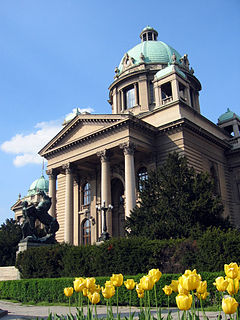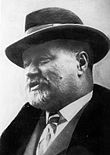Croatia first appeared as two duchies in the 7th century, the Duchy of Croatia and the Duchy of Pannonian Croatia, which were united and elevated into the Croatian Kingdom which lasted from 925 until 1918. From the 12th century the Kingdom of Croatia entered a Personal Union with the Kingdom of Hungary, it remained a distinct state with its ruler (Ban) and Sabor, but it elected Royal dynasties from neighboring powers, primarily Hungary, Naples and Austria.

The Kingdom of Yugoslavia was a state in Southeast Europe and Central Europe that existed from 1929 until 1941, during the interwar period and beginning of World War II.

The Ustaša – Croatian Revolutionary Movement, commonly known as Ustaše, was a Croatian fascist, racist, ultranationalist and terrorist organization, active, as one organization, between 1929 and 1945. Its members murdered hundreds of thousands of Serbs, Jews, and Roma as well as political dissidents in Yugoslavia during World War II.

Ante Pavelić was a Croatian general and military dictator who founded and headed the fascist ultranationalist organization known as the Ustaše in 1929 and governed the Independent State of Croatia, a fascist Nazi puppet state built out of Yugoslavia by the authorities of Nazi Germany and Fascist Italy, from 1941 to 1945. Pavelić and the Ustaše persecuted many racial minorities and political opponents in the NDH during the war, including Serbs, Jews, Romani, and anti-fascist Croats.

The Independent State of Croatia was a World War II fascist puppet state of Germany and Italy. It was established in parts of occupied Yugoslavia on 10 April 1941, after the invasion by the Axis powers. Its territory consisted of most of modern-day Croatia and Bosnia and Herzegovina, as well as some parts of modern-day Serbia and Slovenia, but also excluded many Croat-populated areas in Dalmatia, Istria, and Međimurje regions.
State of Slovenes, Croats and Serbs became merged with Kingdom of Serbia and Kingdom of Montenegro to form the nation of Yugoslavia in 1918. The formation of Yugoslavia began with the formation of the Yugoslav Committee, a collection of mostly Croats, then Serbs and later Slovenes, whose goal was to form a single south Slavic state. In October 1918 the Croatian Parliament declared the Kingdom of Croatia - Slavonia as an independent state, which, in December that same year, incorporated in State of Slovenes, croats and Serbs, merged with Kingdom of Serbia and Kingdom of Montenegro and created the Kingdom of Serbs, Croats and Slovenes. The kingdom would be renamed to Yugoslavia in 1929, and ruled by Serbian Karađorđević dynasty till Second World War. After the formation of Yugoslavia, Serbia attempted to create a "Greater Serbia" by using police intimidation and vote rigging to establish a Serbian controlled Yugoslavia. From 1929-1941 Serbian controlled Yugoslavia established control over Croatia through Royal Yugoslav police force brutality and assassinations of important Croatians.
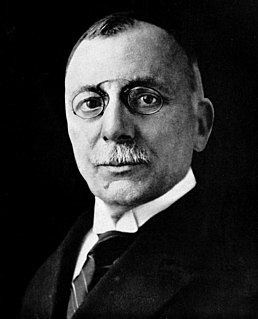
Ante Trumbić was a Croatian politician in the early 20th century.
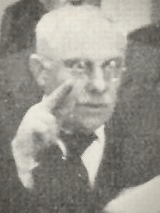
Vladimir "Vladko" Maček was a Croatian politician in the Kingdom of Yugoslavia and as a leader of the Croatian Peasant Party (HSS) following the 1928 assassination of Stjepan Radić, was a leading Croatian political figure until the Axis invasion of Yugoslavia in 1941. As a leader of the HSS, Maček played a key role in establishment of the Banovina of Croatia, an autonomous banovina in Yugoslavia in 1939.

Croatian nationalism is the nationalism that asserts the nationality of Croats and promotes the cultural unity of Croats.
The Croatian Liberation Movement is a minor far-right political party founded in 1956 in Buenos Aires, Argentina, by the Croatian WWII fascist dictator Ante Pavelić who was leader of the Nazi puppet state, the so-called Independent State of Croatia, and some Croatian emigrants.
The Prime Minister of Yugoslavia was the head of government of the Yugoslav state, from the creation of the Kingdom of Serbs, Croats and Slovenes in 1918 until the breakup of the Socialist Federal Republic of Yugoslavia in 1992.
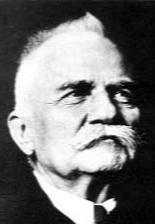
Constitutional Assembly elections were held in the Kingdom of Serbs, Croats and Slovenes on 18 March 1923. The seats were divided up by the political borders which existed before the Kingdom's formation and distributed using the population statistics of 1910.
The Croatian Bloc or the Croatian National Representation was the name held by the wide coalition of Croatian political parties in the Kingdom of Serbs, Croats, and Slovenes from 1921 to 1929's 6th of January Dictatorship and within the Kingdom of Yugoslavia from 1935 to 1941.

Dr. Ante Pavelić (1869–1938), was a Croatian dentist and politician.

Parliamentary elections were held in Yugoslavia on 1 December 1938. The result was a victory for the governing Yugoslav Radical Union, which won 306 of the 373 seats in Parliament.
Juraj Krnjević was a Croatian and Yugoslav politician who was among the leaders of the Croatian Peasant Party (HSS). He was the party's General Secretary since 1928 and President since 1964. He also served as the First Deputy Prime Minister and Minister of Post, Telegraph and Telephone of Yugoslavia between 1942 and 1943.
The Vidovdan Constitution was the first constitution of the Kingdom of Serbs, Croats and Slovenes. It was approved by the Constitutional Assembly on 28 June 1921 despite the opposition boycotting the vote. The Constitution is named after the feast of St. Vitus (Vidovdan), a Serbian Orthodox holiday. The Constitution required a simple majority to pass. Out of 419 representatives, 223 voted for, 35 voted against and 161 abstained.

Mladen Lorković was a Croatian politician and lawyer who became a senior member of the Ustaše and served as the Foreign Minister and Minister of Interior of the Independent State of Croatia (NDH) during World War II. Lorković led the Lorković-Vokić plot, an attempt to establish a coalition government between the Ustaše and the Croatian Peasant Party and align the Independent State of Croatia with the Allies.
The Party of Rights was an influential Croatian political party in the 19th and 20th centuries. The right or rights in the party's name refer to the idea of Croatian national and ethnic rights, which was central to the party's ideology. Numerous modern Croatian and Bosnian Croat political parties claim lineage from it.

